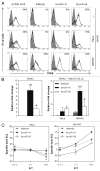Functional comparison of single-chain and two-chain anti-CD3-based bispecific antibodies in gene immunotherapy applications
- PMID: 25057445
- PMCID: PMC4091452
- DOI: 10.4161/onci.28810
Functional comparison of single-chain and two-chain anti-CD3-based bispecific antibodies in gene immunotherapy applications
Abstract
Gene therapy to achieve in vivo secretion of recombinant anti-CD3 x anti-tumor bispecific antibodies in cancer patients is being explored as a strategy to counterbalance rapid renal elimination, thereby sustaining levels of bispecific antibodies in the therapeutic range. Here, we performed a comparative analysis between single- and two-chain configurations for anti-CD3 x anti-CEA (carcinoembryonic antigen) bispecific antibodies secreted by genetically-modified human cells. We demonstrate that tandem single-chain variable fragment (scFv) antibodies and two-chain diabodies are expressed as soluble secreted proteins with similar yields. However, we found significant differences in their biological functionality (i.e., antigen binding) and in their ability to induce non-specific T cell activation. Whereas single-chain tandem scFvs induced human T cell activation and proliferation in an antigen-independent manner, secreted two-chain diabodies exerted almost no proliferative stimulus when human T cells were cultured alone or in co-cultures with CEA negative cells. Thus, our data suggest that two-chain diabodies are preferable to single-chain tandem scFvs for immunotherapeutic strategies comprising in vivo secretion of bispecific antibodies aiming to recruit and activate anticancer specific lymphocytic effector T cells.
Keywords: bispecific antibody; diabody; gene therapy; in vivo secretion; tandem-scFv.
Figures




References
-
- Sebastian M, Passlick B, Friccius-Quecke H, Jäger M, Lindhofer H, Kanniess F, Wiewrodt R, Thiel E, Buhl R, Schmittel A. Treatment of non-small cell lung cancer patients with the trifunctional monoclonal antibody catumaxomab (anti-EpCAM x anti-CD3): a phase I study. Cancer Immunol Immunother. 2007;56:1637–44. doi: 10.1007/s00262-007-0310-7. - DOI - PMC - PubMed
Publication types
LinkOut - more resources
Full Text Sources
Other Literature Sources
